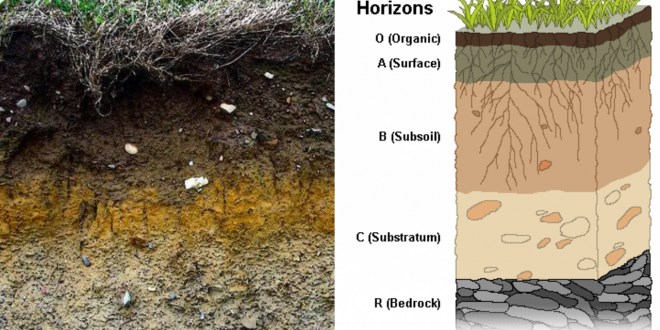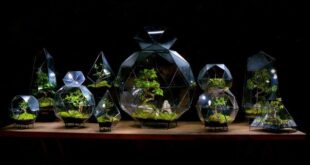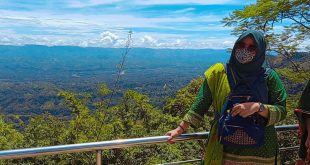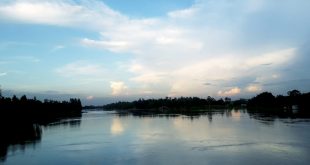Do you ever dig down deep into any soil? If you did so, you may have followed different colors and layers in there. These layers are called horizons in soil science.
The idea of Horizon and Soil Horizons are slightly different.
Horizon is a distinct layer of soil, approximately parallel with the land surface, whose properties develop from the combined actions of living organisms and percolating water.
Soil horizons are layers parallel to the soil surface whose physical, chemical and biological characteristics differ from
the layers above and beneath.
Horizons can be addressed as master horizons (main horizons) are indicated by capital letters. Suffixes, in form of lowercase letters and figures, further differentiate the master horizons.
Soil profile definition
The sequence of the layers of soils is called soil profile.

Soil Horizons
There are commonly 5 layers or horizons found in the soil. They are known as- O, A, B, C & R horizons.

All the horizons have their own characteristics according to it’s properties.
O Horizon Soil
It contains a huge amount of organic matters. Typically, there are 3 distinct organic layers in O horizon-
- Organic layer of leaves.
- Underlain by a partially decomposed layer (Dark in color).
- Layer of well decomposed humus.
Position
Generally O layer is found on the surface of a mineral soil. But it may also be found at any depth below the surface if it is buried.
Matter of concern
Some horizons formed by the illuviation of organic material into a mineral subsoil may contain organic matter. These horizons are not O Horizon.
A Horizon Soil
It is a leached mineral horizon (dark in color) with a high content of organic matter. This horizon is also called ‘Topsoil’.
B Horizon Soil
This horizon is a zone of accumulation of fine materials and mineral Precipitates like as clay, iron, carbonates, gypsum etc. This horizon is also called ‘Subsoil’.
C Horizon Soil
This horizon contains rock fragments of different sizes (partly weathered rocks).
R Horizon Soil
This layer is composed of hard bedrock (unaltered rock layer).
Horizon Development Processes
There are Commonly 4 horizon development processes. They are-
- Additions
- Transformation
- Translocation
- Removal
1. Additions
Additions can be materials that are transported into the location where a soil is forming. For instance, dust with a high calcium carbonate content could be blown on to the developing soil adding calcium to the evolving profile.
When plants die or leaves fall on to the surface they decompose adding organic matter to the soil.
2. Transformation
Transformation of the materials added to the developing soil occur by chemical and biological processes acting on them. For instance, leaves falling on the surface and plant roots dying beneath may decompose into a dark brown, nutrient-rich material called humus. Iron and aluminium can be oxidized under warm, moist climates. Soil material is constantly being transformed in one way or another.
3. Translocation
It involves the movement of soil-forming
materials through the developing soil profile.
Translocation occurs by water running through the soil transferring materials from upper to lower portions of the profile. Burrowing animals like earth worms, ants, etc., move soil materials within the profile. Burrowing animals create passage ways through which air and water can travel promoting soil development.
4. Removal
Removal of soil forming materials means that they are completely removed from the soil profile. Easily dissolved elements like calcium carbonate can be removed from the soil profile under rainy climates.
 Plantlet The Blogging Platform of Department of Botany, University of Dhaka
Plantlet The Blogging Platform of Department of Botany, University of Dhaka






Thank you for this very useful information